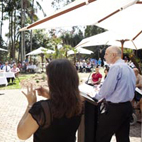Principles and Elements
About this document
 The Blue Skies Scenario is a living vision that has been shared by people from all over Queensland. The Principles and Elements of the Blue Skies Scenario has been made available to:
The Blue Skies Scenario is a living vision that has been shared by people from all over Queensland. The Principles and Elements of the Blue Skies Scenario has been made available to:
- clarify the principles that underpin the Blue Skies vision;
- expand on the key elements of the Blue Skies vision; and
- offer practical actions over the next ten years to make the Blue Skies vision a reality.
While this document does not profess to be complete, it does offer a deeper exploration of the Blue Skies vision.
If you have any feedback to offer about the Principles and Elements of the Blue Skies Scenario, please contact us and let us know.
Principles
Blue Skies endorses the Social Inclusion Principles for Australia.
They are:
1. Reducing disadvantage
Making sure people in need benefit from access to good health, education and other services
2. Increasing social, civil and economic participation
Helping everyone get the skills and support they need so they can work and connect with community, even during hard times
3. A greater voice, combined with greater responsibility
Governments and other organisations giving people a say in what services they need and how they work, and people taking responsibility to make the best use of the opportunities available
4. Building on individual and community strengths
Making the most of people’s strengths, including the strengths of Aboriginal and Torres Strait Islander peoples and people from other cultures
5. Building partnerships with key stakeholders
Governments, organisations and communities working together to get the best results for people in need
6. Developing tailored services
Services working together in new and flexible ways to meet each person’s different needs
7. Giving a high priority to early intervention and prevention
Heading off problems by understanding the root causes and intervening early
8. Building joined-up services and whole of government(s) solutions
Getting different parts and different levels of government to work together in new and flexible ways to get better outcomes and services for people in need
9. Using evidence and integrated data to inform policy
Finding out what programs and services work well and understanding why, so you can share good ideas, keep making improvements and put your effort into the things that work
10. Using locational approaches
Working in places where there is a lot of disadvantage, to get to people most in need and to understand how different problems are connected
11. Planning for sustainability
Doing things that will help people and communities deal better with problems in the future, as well as solving the problems they face now
Please note: For a deeper exploration of important elements from the Blue Skies Scenario, please download the full Principles and Elements of the Blue Skies Scenario document.
